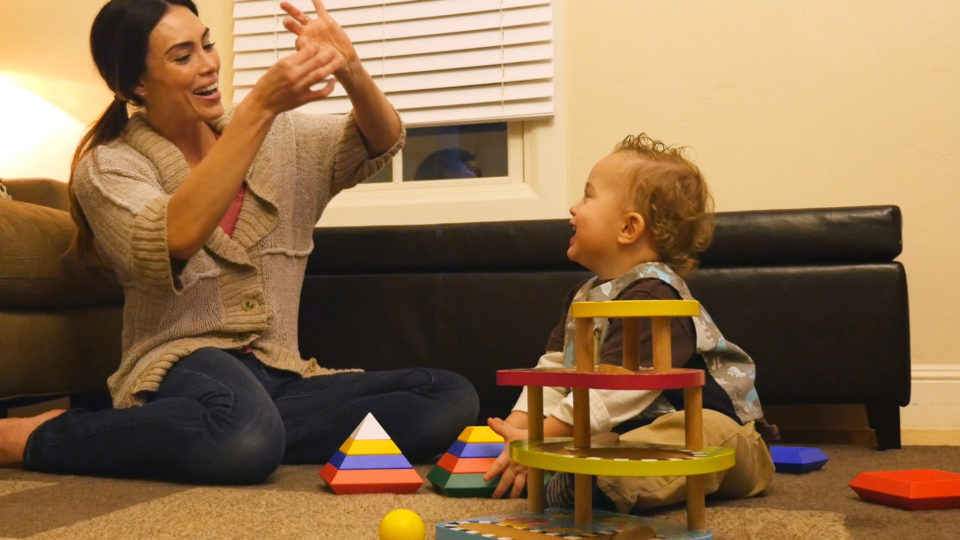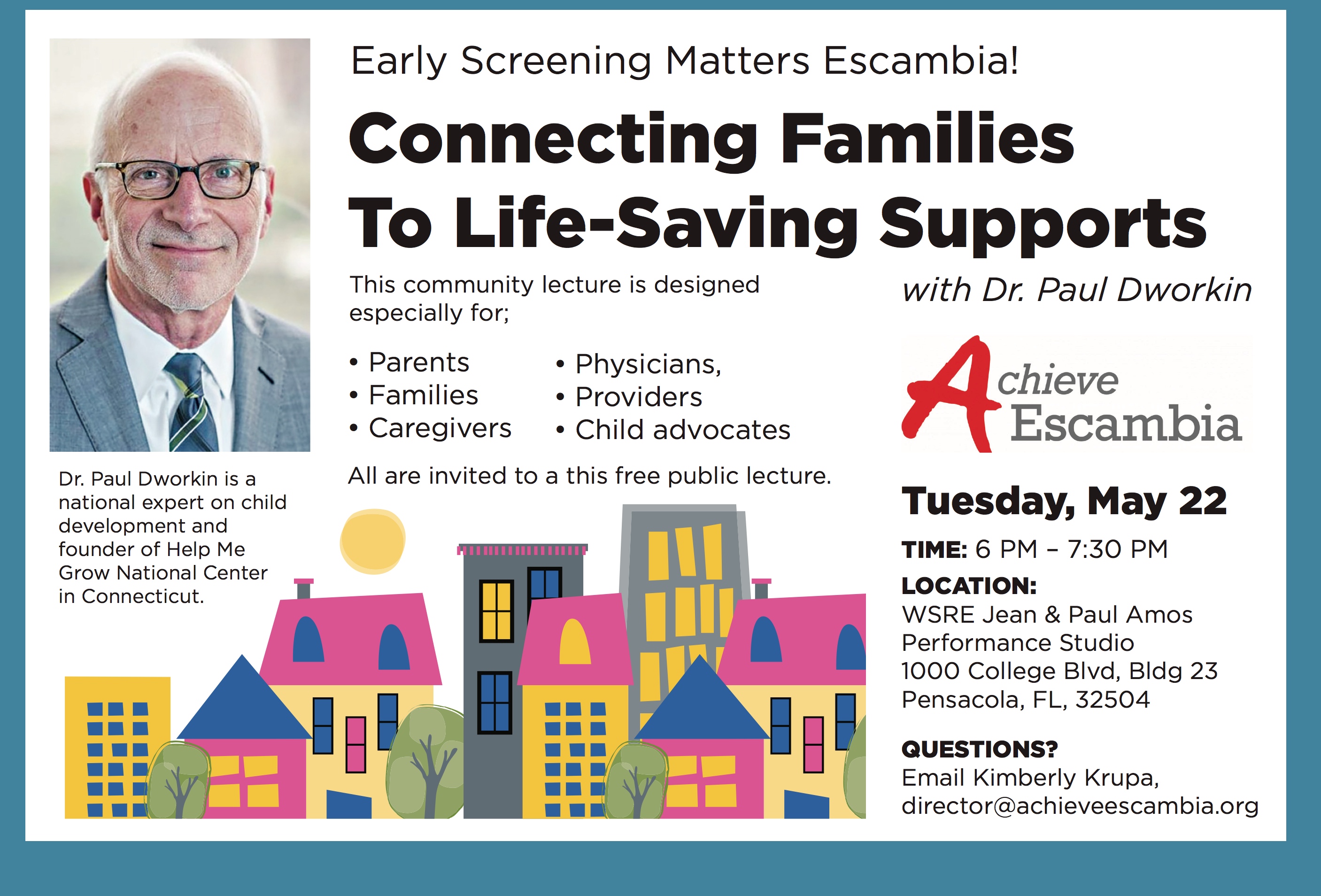Help Me Grow's founder shares story in Pensacola
- May 18, 2018
- / Shannon Nickinson
- / early-learning

Dr. Paul Dworkin is into being relentless.
The Connecticut pediatrician has to be. Children are depending on him.
Thanks to that drive, what started as a pilot program in Hartford, Conn., in 1997 now is being used in 28 states to make life — and life outcomes — better for children under 5.
"I often characterize our work as the relentless pursuit of the answer to the question of how we optimize outcomes for children by identifying young children who are vulnerable and at risk but, not yet manifesting delays or disorders, and for whom referral can help elevate their trajectory to a healthy one and prevent delays that would have been otherwise inevitable,” Dworkin says.
Dworkin is the founding director of the Help Me Grow National Center. He is also executive vice president for community child health at Connecticut Children’s Medical Center, and professor of pediatrics at the University of Connecticut School of Medicine.
Next week, he will share his belief in the power of focusing on young children with Pensacola. At the invitation of Achieve Escambia, Dworkin will spend two days in Pensacola talking with business, civic, education and faith leaders about the role they have in this cause.
On Tuesday, May 22, he speaks publicly at WSRE’s Jean & Paul Amos Auditorium beginning at 6 p.m. about why early screening for developmental delays matters — to a child, to a family, and to a community. For details of the free event, https://www.facebook.com/events/1936154036397374/

How Help Me Grow started
Dworkin calls the 1990s “the decade of the brain.”
That’s when research revealed more about early brain development and how it could influence the health of a child — and a family.
Key among those findings is the “achievement gap.” As noted by University of Kansas researchers Betty Hart and Todd Risley, children from lower income families tend to hear fewer words — and fewer words that are positive and encourage interaction, curiosity and exploration — by age 4 than children from better-off families.
That word gap adds up to 30 million fewer words heard in the first three years of life. That gap impacts a child’s school readiness, early language development skills and the foundation for learning to read.
Dworkin says early developmental screening and detection are key to the best possible outcome for a child.
And the key to early detection is making sure that parents, caregivers, childcare providers and the whole network of adults who work with young children all know what to look for and have a common tool to use to check for it.
From 1997 to about 2002, Help Me Grow was piloted in Hartford, Conn. It went statewide in 2002. Between 2006-2007, the work began on replicating what happened in Hartford in other communities — the first being Orange County, Calif.
Now, Dworkin says, the center has helped 30 states and 105 systems. Nationally, the network helped 153,417 families in 2017.
Working at that scale is not something Dworkin says he envisioned for the center.
“We thought if we could bring it statewide, that would be the crowning achievement of Help Me Grow,” he says. “As others began to hear about it, we realized there was an audience.”
The national center was founded with a $2.5 million grant from the W.K. Kellogg Foundation.
“Now our goal is to ensure Help Me Grow is in every state,” Dworkin said.
How it works in Florida
The concept is already at work in Florida, but not in Escambia County.
Help Me Grow Florida acts as a coordinating office for local affiliates. Tamara Price, statewide director of Help Me Grow Florida, said 27 counties — most in the southern and central Florida — are affiliates.
The Big Bend affiliate is the closest affiliate to Pensacola.
The aim is to provide developmental screenings, resources and referrals to parents to help them know what to look for as their children develop, and where to go to ask for help. Help Me Grow also works with children’s healthcare providers as well to make sure that they have the tools as well.
“We operate (Help Me Grow) like a one-stop shop, the open door for parents without them trying to find those resources on their own,” Price said. “We help navigate the system from referrals for more assessments to doing the screenings for physicians, to following up with feedback and working with families.”
In Florida, Help Me Grow’s partner is 211.
Statewide, Price says Help Me Grow serves 3,500 children per year, most under age 4. The first two affiliates came on in 2012; the majority came on line in 2015.
Making sure that pediatricians, clinic staff, childcare providers, service providers are all “singing from the same sheet music” when it comes to the importance of the first 1,000 days of a child’s life is key to making the system work.
Also mission-critical: Ensuring that Help Me Grow care coordinators are well-trained and versed in the resources available in their community. Help Me Grow staff will conduct developmental screenings, or help providers access and use the screening tool, and follow-up.
“One of the things we ask for from our affiliates is a commitment to training,” Price said.
Price said the state office is working on setting up training guidelines to ensure “best-practices” by a Help Me Grow care coordinator. Price hopes to have at least 12 such training modules ready and available for affiliates to use by 2019.
Capturing data about the impact Help Me Grow has on a community’s children under 4 is the next piece Price hopes to see finalized.
“The data piece is not yet what we’ve been able to put our hands around,” she said. “We haven’t figured out the best way to do that.”
Price said HMG Florida will be among the entities that participate in a statewide grant project that aims to identify agencies that are doing developmental referrals, what referrals families are getting and what the outcomes are.
Help Me Grow is not just about working with families, Price said.
“It’s also about pediatricians and healthcare providers getting the word about screening kids, or refer them us and allow us to screen them and share back the results,” Price said.
Affiliates are asked to do a monthly outreach effort with healthcare providers, be it offering education, training or materials to pediatric offices to do screenings, she said. In some communities that outreach includes early learning coalitions and childcare providers, too, Price said.
“Look, I have three kids and I was never given a parenting guide,” Price says. “It’s important for parents to understand what it means for a child to be developing typically.
“Parents need to know as early as they can to stimulate (their children) and make sure they reach their milestones at a regular rate. We know it impacts them in school, it impacts their learning. We want to help parents know what they should be looking for.”
Tracking impact
Nationally, Help Me Grow tracks its impact by the percentage of families who access the system and are successfully linked to a community based service or program. Nationally, that rate is 80 to 82 percent, Dworkin says.
He also says they are looking at more ways to demonstrate the return is boosting the developmental and academic status of children, and even improving occupational and societal outcomes.
“That’s data that is challenging to gather, but we are committed to that,” Dworkin says.
Anecdotally, the impact touches families in ways large and small every day, Price says.
Price thought of one family with a child who was not speaking as much as they should be. Turned out, the child was having recurring ear infections. The Help Me Grow care coordinator sent the family first to an ear, nose and throat specialist, who put tubes in the little one’s ears to handle the medical issue.
“The child wasn’t developing language they way they should because the child wasn’t hearing the language,” Price said. Once the doctor put tubes in, “then the child’s language started to progress.”
Funding streams
Each Help Me grow affiliate finds its funding in its own approach.
In Connecticut, Dworkin and the team were able to get Help Me Grow Connecticut into the state budget as a line item, where it has remained since 2002, he says. That program has used a blend of foundation and grant funding, government, and other funding sources also to support their work.
In Florida, Help Me Grow communities have used some federal grant dollars, state funding and funding from Children’s Services Councils to support their work. CSCs are created by special taxing districts — approved by voters and based on property taxes — to create a funding stream for agencies that work on children’s health, education and well-being.
There are eight such districts in Florida, but Escambia County is not one of them. In California, Help Me Grow is part of First 5, which receives funding for early childhood systems from tobacco taxes.
Figuring out the funding puzzle is important — and Dworkin says it is something that requires a community to take the long view.
“We make investments and we know there’s a return in that investment, but the return takes years to decades to accrue, and the returns comes in (savings in) special education, behavioral health and the corrections system,” he says.
“We need to figure out ways to demonstrate a return on investment in the short and long term,” he says. “We’re working on that.”
One example, Dworkin says has to do with children seen by a pediatrician whose parents say they are dealing with difficult behavior issues. In a system without Help Me Grow, Dworkin says there is 16 percent likelihood that child will be referred for further medical evaluation.
In a Help Me Grow system, the likelihood of a medical referral drops to 6 percent. Instead, families are referred to community-based parenting programs or other support services that will be helpful — and that don’t come at the same cost to the healthcare system as a medical specialist’s appointment.
“We asked colleagues at Yale Management School to look at just that one small piece to see if it were brought to scale, what would it save,” Dworkin said. “The figure they brought us back was $54 million a year.
Dworkin says the national center’s goal for this coming year to develop with others more methodologies to track such impacts “so we can engage the skeptics and demonstrate why this investment is worthwhile.”
 CivicCon launches with a look at good growth in cities
CivicCon launches with a look at good growth in cities
 Building stronger brains one baby, one parent at a time
Building stronger brains one baby, one parent at a time
 SCI debuts commercial on Early Learning City
SCI debuts commercial on Early Learning City
 Entrecon: World class speakers and an opportunity to sharpen skills
Entrecon: World class speakers and an opportunity to sharpen skills
 PYP Quality of Life survey 2017
PYP Quality of Life survey 2017
 EntreCon Pensacola 2016: A look back
EntreCon Pensacola 2016: A look back
 Leadership tip: getting better employee takeaways
Leadership tip: getting better employee takeaways
 Leadership tip: be interested instead of interesting
Leadership tip: be interested instead of interesting
 Leadership tip: delivering difficult messages
Leadership tip: delivering difficult messages
 Brain Bags boost Arc, Early Childhood Court programs
Brain Bags boost Arc, Early Childhood Court programs